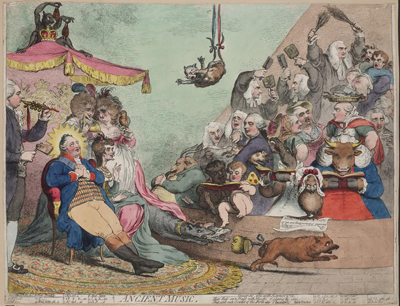Ancient Music
The title of this print derives from a series of concerts, The Concerts of Antient Music initiated by a group of noblemen in 1776 and continued annually until 1848. Using a rather broad definition of "ancient," the concerts were designed to showcase music that was at least 20 years old. By 1787, the time of Gillray's print, the concerts were held at the New Rooms or (as they began to be called around this time) the Antient Music Rooms on Tottenham Street. The season was typically composed of 12 concerts plus a benefit concert featuring Handel's Messiah. Though by 1785 regularly attended by King George and Queen Charlotte, the concerts were largely financed by public subscription, rather than by the crown itself, a characteristically frugal decision by the royal pair which is alluded to in the person of the imp sitting on the royal canopy and holding up what were then called "miser purses"—one for each of the royals.

© Lewis Walpole Library, Yale University
But what the pair seems to be listening to and presiding over is not so much the harmony of ancient music but strife, discord, and cacophony as the "performers" and audience members seem determined to outdo one another in the production of noise.
A quick review of the sounds portrayed in the print includes barking dogs, caterwauling cats, shrieking children, squabbling fishwives, the clanking of chimnney sweeps, the tinkling of bells, and the trill of a whistle, a braying ass, a squawking parrot, a squealing pig, a snorting bull, and a sneezing lawyer. In this determined pursuit of portraits of cacophony, Ancient Music recalls nothing so much as Hogarth's Enraged Musician (1741) where the poor violinist at his window tries to shut his ears to the din ouside. But in this case far from being angered by it, the King seems inexplicably enraptured by the pandemonium.
In this, the likely second, state of the print, there is a key which enables or confirms the identification of the people being portrayed. They are mostly musicians and/or the organizers of the concert (usually portrayed as animals) and politicians (usually shown bickering with one another).
So, for instance, we know that the long-horned goat asleep in the first row is the Welsh landowner and supporter of the concerts, Sir Watkin Williams-Wynn; that the braying ass singing from a book is the musician John Asbridge; and that the bird looking askance at the Royal couple is the soprano Madame Mara who was personally requested to give a private performance for the King and Queen and never compensated (according to Peter Pindar).
On the political side, we also know that the royal hounds chasing the fox with a pot resembling Lord North tied to his tail is a reference to the much-hated coalition government formed by Fox and North in spite of the King's objection. At the first opportunity, the King made sure that Fox and North were driven from office, and for decades, the King refused to allow Fox anywhere near a position in government. Similarly, the belligerent fishwives include the Duke of Richmond whose proposals for new fortifications against a French assault were vigorously attacked by Marquess of Lansdowne and the blind Colonel Barré (also represented as fishwives). And finally, the dueling chimney sweeps represent Henry Dundas and Alexander Wedderburn who were on opposite sides in the Knight vs. Wedderburn case, which Dundas ultimately won in defense of Knight.
At the bottom of the print is a quotation from Ode Upon Ode, or, a Peep at St James's by the verse satirist Peter Pindar (the source of the Madame Mara story). As his title suggests, Pindar's poem is an ode upon an ode, a parody of the twice yearly odes required to be written by the British poet laureate (in this case Thomas Warton.) The laureate's odes were delivered with the start of the new year and on the King's birthday (June 4) to
------Monarchs, who with Rapture wild,
Hear their own Praise with Mouths of gaping Wonder,
And control each Crotchet of the Birth-day Thunder.
Pindar contrasts his ode with that of Warton, in being able to speak the unvarnished truth. And, presumably, Gillray's print follows suit, showing a monarch and his consort unable to distinguish music from noise, a baby-ish prime minister playing with a noisemaker and a child's whistle and the political life of the country consisting of the settling of old scores.
Sources and Reading
- Commentary from the British Museum on Ancient Music.
- "Concerts of Antient Music," Wikipedia
- "Miser Purses," Regency World
- "George III," Wikipedia
- "Charlotte of Mecklenburg-Strelitz," Wikipedia
- "William Pitt the Younger," Wikipedia
- "Juliane von Schwellenberg," Wikipedia
- "Charles James Fox," Wikipedia
- "Frederick North, Lord North," Wikipedia
- "Joah Bates," Wikipedia
- "Gertrud Elisabeth Mara," Wikipedia
- "Charles Lennox, 3rd Duke of Richmond," Wikipedia
- "Henry Dundas, 1st Viscount Melville," Wikipedia
- "William Petty, 2nd Earl of Shelburne," Wikipedia
- "Alexander Wedderburn, 1st Earl of Rosslyn" Wikipedia
- "Joseph Mawbey," Wikipedia
- "Sir Watkin Williams-Wynn, 4th Baronet," Wikipedia
- Peter Pindar, Ode Upon Ode, or, a Peep at St James's (1787)
- Thomas Wright and R.H. Evans, Historical and Descriptive Account of the Caricatures of James Gillray #23.
- Thomas Wright and Joseph Grego, The Works of James Gillray, the Caricaturist; With the History of His Life and Times, p. 85-86.
Comments & Corrections
NOTE: Comments and/or corrections are always appreciated. To make that easier, I have included a form below that you can use. I promise never to share any of the info provided without your express permission.